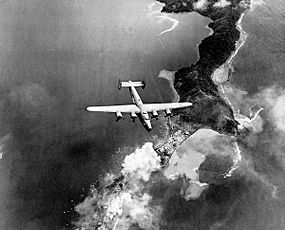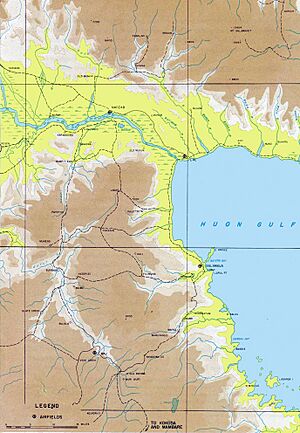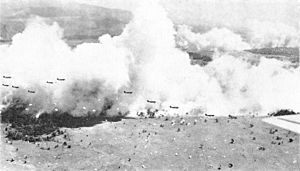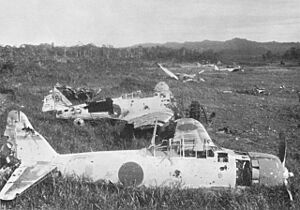Salamaua–Lae campaign facts for kids
Quick facts for kids Salamaua-Lae campaign |
|||||||
|---|---|---|---|---|---|---|---|
| Part of the New Guinea Campaign of the Pacific Theater (World War II) | |||||||
 A US Army Air Forces B-24 Liberator bomber, flying over explosions on the Salamaua Peninsula, where the port is located. |
|||||||
|
|||||||
| Belligerents | |||||||
| Commanders and leaders | |||||||
|
|
|||||||
| Units involved | |||||||
|
|
||||||
| Strength | |||||||
| ~30,000 | ~10,000 | ||||||
| Casualties and losses | |||||||
|
Australia: 81 killed and 396 wounded |
11,600 killed, wounded or captured | ||||||
The Salamaua–Lae campaign was a series of battles during World War II. It took place in New Guinea in 1943. Australian and United States forces worked together. Their goal was to capture two important Japanese bases. These bases were in the towns of Lae and Salamaua.
The fighting began after the Allies successfully defended Wau in January 1943. Australian troops then started moving towards Mubo. Japanese soldiers who had attacked Wau retreated to Mubo. Over several months, the Australian 3rd Division pushed north-east towards Salamaua. After a landing at Nassau Bay, US troops joined the Australians. They advanced along the coast.
While the Allies pressured the Japanese near Salamaua, they also planned a big attack on Lae. In early September, they launched an airborne assault on Nadzab. At the same time, they made a sea landing near Lae. This allowed them to attack Lae from two sides. As the situation in Lae became difficult, the Japanese soldiers in Salamaua pulled back. Salamaua was captured on 11 September 1943. Lae fell shortly after, on 16 September. This brought the campaign to an end.
Contents
Why This Battle Happened
In March 1942, Japanese forces took control of Salamaua and Lae. They built major military bases on the north coast of New Guinea. Lae was a large town, and Salamaua was a smaller port. Salamaua was used as a stop for planes attacking Port Moresby. It was also a supply base for Japanese forces.
The Japanese could only keep about 10,000 soldiers and sailors in the Salamaua–Lae area. Their defenses were led by Major General Toru Okabe. His group was called the Okabe Detachment. In January 1943, this group attacked the Australian base at Wau. But they were defeated in the Battle of Wau.
After this, Allied commanders decided to attack Salamaua. Troops could fly into Wau and then move towards Salamaua. This attack also helped distract the Japanese from Lae. Lae was a bigger target for the Allies' overall plan, called Operation Cartwheel. The plan was for the Australian 3rd Division to chase the Japanese towards Salamaua. They would then meet up with parts of the US 41st Infantry Division.
Fighting for Salamaua
After the fighting at Wau ended in January, the Japanese Okabe Detachment moved back to Mubo. They had about 800 soldiers there. From April to May 1943, the Australian 2/7th Infantry Battalion attacked Japanese lines near Mubo. They faced strong Japanese defenses.
At the same time, Major George Warfe's 2/3rd Independent Company attacked Japanese positions at Bobdubi Ridge. They caused heavy losses for the Japanese. In May, the 2/7th Battalion fought off several strong Japanese counterattacks.
The Australian 24th Infantry Battalion also helped. They patrolled the area around the Markham River. One patrol even reached the Bituang River, north of Salamaua.
In response, the Japanese commander, Lieutenant General Hatazō Adachi, sent more troops. The 1,500-strong 66th Infantry Regiment arrived. They attacked at Lababia Ridge in June. The Australian "D" Company of the 2/6th Battalion defended the ridge. They used strong defensive positions and fought bravely. They stopped the Japanese attack.
From June to August, the Australian 15th Infantry Brigade cleared Bobdubi Ridge. This involved intense hand-to-hand combat. Also, in June, the US 162nd Regimental Combat Team landed at Nassau Bay. They faced no resistance and set up a beachhead. This allowed them to bring in heavy guns and advance along the coast.
A week later, the Australian 17th Brigade attacked Japanese positions at Mubo again. The Japanese pulled back to avoid being surrounded. Their commander, Hidemitsu Nakano, decided to gather his forces in the Komiatum area, south of Salamaua.
The US 162nd Regimental Combat Team faced strong resistance at Roosevelt Ridge. This battle lasted from July to August. Meanwhile, the Australian 42nd and 2/5th Infantry Battalions fought hard to gain ground on Mount Tambu. They held their positions despite strong Japanese counterattacks. By the end of July, about 8,000 Japanese soldiers were in the Salamaua area.
On 23 August, the Australian 5th Division took over the Salamaua operation. They continued to push the Japanese back. The 58th/59th Infantry Battalion crossed the Francisco River. The 42nd Infantry Battalion captured a main Japanese defense position. After the Allied landings near Lae in early September, the Japanese commander ordered his troops to leave Salamaua. Between 5,000 and 6,000 soldiers left by boat. Others marched along the coast. The 5th Division entered Salamaua on 11 September. They secured its airfield.
The fighting for Salamaua was costly. The Australians had 1,083 casualties, including 343 killed. The Japanese lost 8,100 soldiers, with 2,722 killed. The US 162nd Regiment lost 81 killed and 396 wounded. Allied planes and US patrol boats supported the troops. They also blocked the sea routes.
Operation Postern: The Plan for Lae
The main plan to capture Lae was called Operation Postern. It was part of a larger plan to secure the Huon Peninsula. General Thomas Blamey and Lieutenant General Sir Edmund Herring planned the operation. It was a "pincer movement." This means attacking from two sides. One attack was an amphibious assault (from the sea) east of Lae. The other was an airborne landing (by air) near Nadzab, west of Lae.
The Australian 9th Division had 547 casualties during Operation Postern. This included 115 killed and 73 missing. The 7th Division had 142 casualties, with 38 killed. The Japanese lost about 1,500 killed. Another 2,000 were captured.
Capturing Lae from the Sea
On 4 September, the Australian 9th Division, led by Major General George Wootten, landed east of Lae. They landed on "Red Beach" and "Yellow Beach." This started the plan to surround the Japanese in Lae. Five US Navy destroyers helped by firing their guns. The Japanese did not fight them on land at first. But Japanese bombers attacked the landing craft. This caused many casualties among the naval and military personnel.
The 20th Brigade led the attack. The 26th followed, and the 24th was kept in reserve. The 9th Division faced difficult natural barriers. Rivers were swollen from recent rain. They stopped at the Busu River, which was too wide to cross easily. Japanese soldiers were on the other side. On 9 September, the 2/28th Infantry Battalion bravely crossed the Busu River. They secured a bridgehead after fierce fighting.
Capturing Nadzab from the Air
The next day, the US 503rd Parachute Infantry Regiment made a parachute jump at Nadzab. This was just west of Lae. They were joined by Australian gun crews. These Australians had learned to parachute quickly. They brought their special artillery pieces with them. The airborne forces secured Nadzab Airfield without a fight. This allowed the Australian 7th Division, led by Major General George Vasey, to fly in. Their job was to stop any Japanese soldiers trying to escape into the Markham Valley.
The 7th Division suffered its worst losses of the campaign on 7 September. A B-24 Liberator bomber crashed while taking off at Port Moresby. It hit five trucks carrying soldiers from the 2/33rd Infantry Battalion. Sixty soldiers died, and 92 were injured.
On 11 September, the 7th Division's 25th Infantry Brigade fought about 200 Japanese soldiers. They were dug in at Jensen's Plantation. The Australians killed 33 enemy soldiers. Then, the 25th Infantry Brigade fought a larger Japanese force at Heath's Plantation. They killed 312 Japanese soldiers there. It was at Heath's Plantation that Private Richard Kelliher earned the Victoria Cross. This is the highest award for bravery in the British Commonwealth. The 25th Infantry Brigade entered Lae on 15 September. They met up with the 9th Division's 24th Infantry Brigade that same day.
What Happened Next
The capture of Lae was a clear victory for the Allies. It happened faster and with fewer losses than expected. However, many Japanese soldiers escaped. They went through the Saruwaged Range north of Lae. These soldiers would have to be fought again later. This led to the Huon Peninsula campaign. A quick follow-up landing was made at Scarlet Beach.
Salamaua was not developed into a major base. Three days after its capture, an Australian commander visited Salamaua. He found mostly bomb craters and damaged buildings. He suggested focusing all efforts on Lae instead. Salamaua was not a good place for a port or airbase. But by drawing Japanese attention away from Lae, the attack on Salamaua had served its purpose.
Lae, however, became two important bases. One was for the Australians, and one for the US. These bases were combined under Major General Milford. The development of Lae was slow at first. This was because the main road to the Nadzab airbase was in poor condition. Heavy rains in October closed the road until December. Until then, Nadzab had to be supplied by air.






